Solutions
01/202021
Lighting Solutions of badminton court in gymnasium
1.Overview of badminton court lighting in the stadium
The lighting of the badminton hall usually adopts three forms, namely natural lighting, artificial lighting and the combination of both.Modern badminton court is mostly mixed lighting, among which the artificial lighting of badminton court is general lighting.In the design of the badminton hall, in order to make the players accurately judge the path, height and landing point, the first thing is to make the best use of natural light. The effect of natural light is the best. Of course, glare should be prevented, and excessively strong light should not be directly or reflected into the eyes.The second is to increase the illuminance of the stability and distribution of uniformity, coordination, etc.This is important not only for the excellent performance of the athletes, but also for the accurate judgment of the judges and the appreciation of the audience.Lighting design and Engineering.
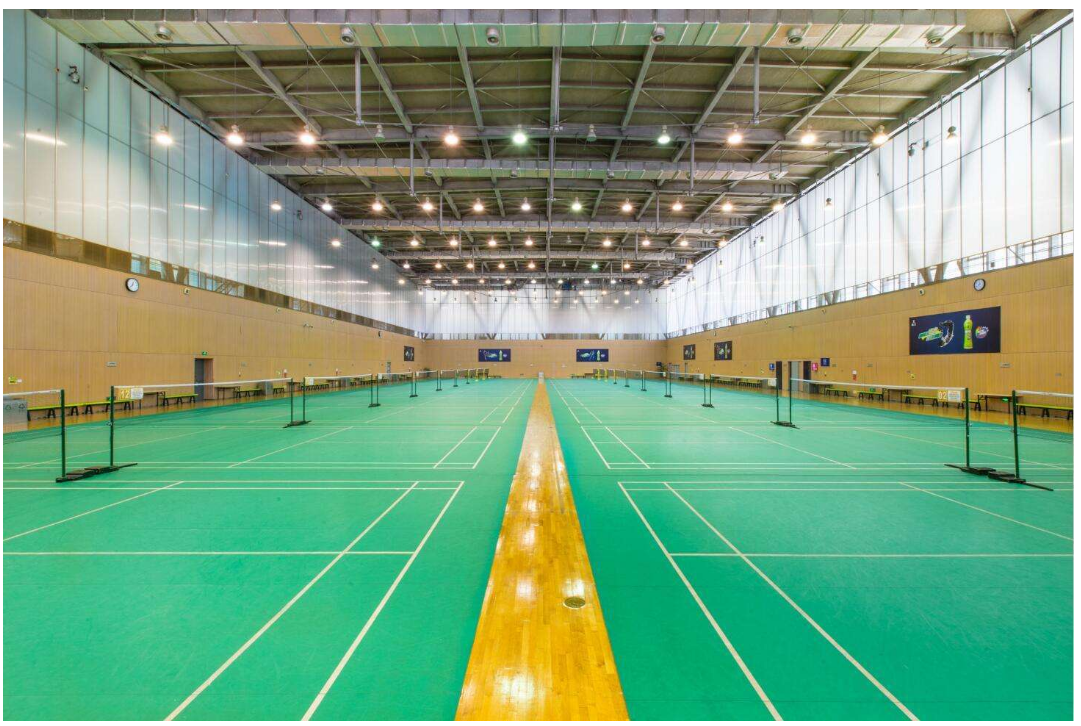
2. Influencing factors of lighting quality in badminton court
The lighting quality of the sports ground is mainly considered from the following five aspects :1) Illumination level: whether the illumination reaches the standard or not.2) Uniformity of lighting: Whether the illumination of the playing field is uniform.3) Glare: whether the glare is obvious.4) Luminance ratio: the color and brightness difference between the object and the background.5) Stability of lighting: whether there is stroboscopic light.
3. Example analysis of badminton field lighting design
After field observation, both sides of the badminton court and the outside of the stadium are glass walls, while the other two sides are walls.In sunny days, the average illumination of the badminton court is 410.75 lx, reaching the national training standard of 300 LX.The measured &#118alues are shown in Figure 1.
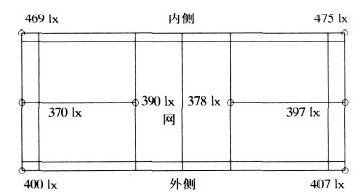
Picture 1:Light measurement in badminton court 1
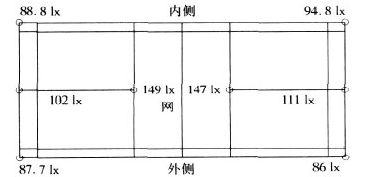
Picture 2:Light measurement in badminton court 2
Relevant conclusion :1) The data in Figure 1 is obtained after measuring with the illuminance meter, and the illuminance reaches the standard.2) Uniform illumination is obtained from FIG. 1.3) No glare.4) Can clearly distinguish the badminton from the surrounding environment;Color, brightness difference suitable.5) No strobe, stable lighting.Therefore, the lighting environment of the badminton court in the daytime gymnasium is relatively suitable.Therefore, the following light environment analysis is only carried out for the badminton court at night.
Lighting design and Engineering
3. 1 Illumination level
Generally speaking, the vertical illumination should be greater than 1/2 of the horizontal illumination, when the vertical illumination is equal to the horizontal illumination, the motion environment is the most ideal.
As shown in Figure 2, the average illumination &#118alue of the badminton court is 107.037 5 lx(there is no obvious light source around the stadium to affect the illumination in the stadium).
Relevant conclusion: The data in FIG. 2 obtained after measurement with an illuminometer shows that the illuminance does not conform to the national training standard (GB 5003422004) 300 LX.
The main reasons are as follows :1) Direct lighting on the top.Ceiling lighting appliances are embedded and equidistant.This way of lighting uniformity is good, but the vertical illumination is difficult to meet the requirements.According to the survey of [3], most stadiums in China adopt this kind of lighting method. Because the lamps are all single narrow light distribution lamps, the vertical illumination is generally not enough, only 1/4 ~ 1/3 of the horizontal illumination.2) Distribution of lamps and lanterns.Lamps are sparse and unreasonably distributed.The distance between the sideline lamp and the field shall be L / 3 ~ L / 2 (L is the spacing of the lamps).If the reflective coefficient of the field, especially the wall, is too low, the distance between the light and the field can be reduced to less than L / 3.
Practical analysis: The distance between the field side lamp and the field side is L/ 2, which conforms to the theoretical requirements. In practice, the surrounding lamps should be encrypted and the method of combining uniform cloth lamp with group cloth lamp should be adopted.Solution: Increase illumination mainly by adding lamps and lanterns.
3. 2 Uniformity of lighting
The uniformity of illumination is used to measure the visual conditions within the venue.Uniformity means that the stadium should be illuminated uniformly, and the areas should not be too bright or too dark, so as to provide good visual conditions for athletes, spectators and judges.As a simple example, for TV coverage, the camera should not have a large variation in illumination as it takes a panoramic view of the game area, which would cause the camera to be exposed.Practical analysis: The measured data show that the illumination is uniform throughout the day and night.Lighting design and Engineering
3. 3 glare
Glare is another important factor in the evaluation of lighting quality. The generation of glare is related to the installation method, installation height, quantity and density of lamps, and light distribution of lamps.
When there is too much brightness contrast in the field of vision, people will feel dazzling, thus affecting people's vision.If you look at the sun at noon on a sunny day, you may feel unable to open your eyes. This is the glare caused by excessive brightness, as shown in Figure 3.
Actual analysis: The badminton court glare is direct glare. Because the ceiling is low, the light source is very harsh when the athletes are doing sports. After a long time, the eyes are uncomfortable, which seriously affects the athletes' observation of the ball movement.
Conclusion: The location of the light source causes glare.
Reason: The position of the lamp is unreasonable, as shown in FIG. 4.
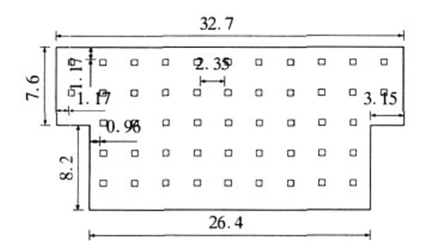
Height of badminton court :5.15m
Solutions :1) Overhead lighting: In the stadium, the athletes' eyes mainly move quickly above the long axis of the court, so the lighting fixture should not be set above the net as far as possible. It is advisable to use overhead lighting.2) Appropriately increase the brightness of the surrounding environment and reduce brightness contrast.The optimal ratio of observation object, site and surrounding environment was 5:2:1.
3. 4 brightness ratio
The eye must have one of two conditions to distinguish objects in the background, that is, the background and the object have a different color, or the background and the object have a certain brightness contrast.If the object is brighter and the background is darker, the better the vision.On the contrary, the background is brighter than the object, the vision will be significantly reduced.When the lighting conditions are very poor, especially the lack of poor brightness, it may cause false visual phenomena, distort perceived objects, and adversely affect the judgment of important information.Lighting design and Engineering
Actual analysis: the color of badminton is white, and the background wall is white.
Related conclusion: Athletes can't see the ball clearly.
3. 5 Stability of light source
Lighting stability directly affects people's health, lighting instability will lead to athletes vision reduction.The stability of illumination is mainly reflected in the stroboscopic effect.Stroboscopic light is caused by the periodic change of the current when the AC power supply is supplied, and the periodic change of the light flux also occurs, which makes people have an illusion when observing the moving object.
Practical analysis: after observation, the site artificial lighting has obvious stroboscopic light.Observe the movement of badminton, you can see a more fuzzy shadow, low resolution.
Conclusion: Stroboscopic damage to human vision.
Reason: The periodic change of current causes the instability of light source.
Solution: use adjacent lamp by different phase power supply, namely divide two fluorescent lamps
Do not connect to different two - phase power sources to form a group.Due to the working current of the two tubes
With different phases, the flux can compensate each other, thus greatly reducing stroboscopic light.
3. 6 Calculation of illumination
3. 6. 1 formula
The time was chosen at night, and the average illumination in the room was 107.037 lx, compared to countries
Standard (GB 5003422004) Badminton training illuminance to reach 300 LX;The race reached 750 lx.
Δ E = E measured on a standard - E = 192. The 962 lx.
By the illuminance formula:
Δ E = & lt;•N• o• / S K[4]
Introduction: N = Δ ES K/eta o<, eta.
Among them, & lt;For the luminous flux per lamp, LM;O is the shading grid efficiency;Is the coefficient of light utilization;S is the site area,m2;N is the number of lamps,K is the compensation coefficient of dimming (the badminton field is the general light, with no K &#118alue).
3.6.2 Calculation steps
1) The length and width of the badminton court, namely, L and W, can be obtained from Figure 4, so as to obtain the ground area S = L &#8226; W = 365.46 m2.2) Height of motion: 1.75 m;Pitch height: H = 5.15m.3) chamber index: I = S/ h (l + w) = 1.91 [4].4) reflex coefficient: = 70[4], reflex coefficient: ceiling (aluminum) = 70[4].5) lamp utilization coefficient w = 0.45 [4].6) The efficiency of 4 × 40W fluorescent lamp with embedded grid (aluminum grid) is 63%, and the luminous flux is 4 × 2,400 = 9,600lm.
Computing: N = Δ ES K/eta o<&#8226; [4] = 192. 962 5 ×365. 46/ (9,600 × 0.45 × 0.63) ≈ 25.91 ≈26 pieces.
To meet the training standard of 300 LX, 26 4 x 40 W lamps should also be added.To allow for reduced reflected light, 27 additional lamps are added.
3. 6. 3 Inspection of luminaries
The above results are verified by the unit capacity method and the lamp distribution design is carried out below:
When Δ E = 192. 962 lx, illumination area capacity per unit area:
W is equal to 11 W over m2 [4].
According to the formula, W = number of bulbs per lamp × bulb power:
P = WS = 11 × 365.46 = 4 020.06 W[4].
N = P/ W = 4 020.06/160 ≈26 [4]'s.
Where, P is the total power [4].
According to the analysis of the actual situation, there are 49 lamps in the badminton stadium, but the illumination is far from the standard, which not only affects the athletes' receiving and serving, but also causes certain harm to the athletes' and referees' eyesight.Therefore, the illumination of such stadiums should be further increased by increasing the number of lamps.In this study case, 27 additional lamps were finally determined, and the total number reached 76 after improvement. The average illumination E = 307.2 lx was measured.
3. 6. 4
The top side lighting is adopted, and the lamps are distributed in two rows inside and outside.The four lamps are in one group, 11 for experts and 8 for amateurs, as shown in Figure 6.
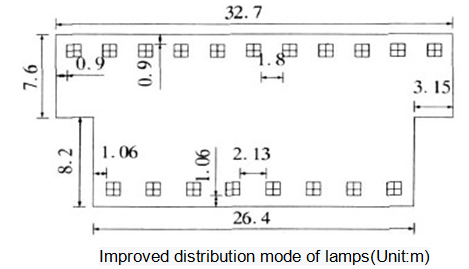
4 conclusion
This paper summarizes five important factors of lighting design of badminton court, and takes the badminton court of a gymnasium of a university as an example, analyzes the existing lighting environment problems, and puts forward relevant improvement measures and requirements of lighting environment design.With the continuous development of science and technology, lighting technology is also constantly improving, the development and use of new lighting technology and the presentation of lighting environment theory will certainly bring a better environment to the society.
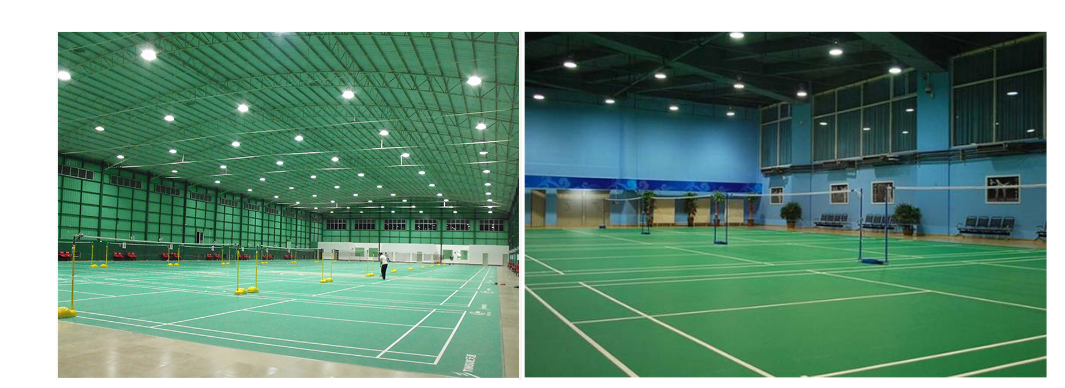
The lighting of the badminton hall usually adopts three forms, namely natural lighting, artificial lighting and the combination of both.Modern badminton court is mostly mixed lighting, among which the artificial lighting of badminton court is general lighting.In the design of the badminton hall, in order to make the players accurately judge the path, height and landing point, the first thing is to make the best use of natural light. The effect of natural light is the best. Of course, glare should be prevented, and excessively strong light should not be directly or reflected into the eyes.The second is to increase the illuminance of the stability and distribution of uniformity, coordination, etc.This is important not only for the excellent performance of the athletes, but also for the accurate judgment of the judges and the appreciation of the audience.Lighting design and Engineering.

2. Influencing factors of lighting quality in badminton court
The lighting quality of the sports ground is mainly considered from the following five aspects :1) Illumination level: whether the illumination reaches the standard or not.2) Uniformity of lighting: Whether the illumination of the playing field is uniform.3) Glare: whether the glare is obvious.4) Luminance ratio: the color and brightness difference between the object and the background.5) Stability of lighting: whether there is stroboscopic light.
3. Example analysis of badminton field lighting design
After field observation, both sides of the badminton court and the outside of the stadium are glass walls, while the other two sides are walls.In sunny days, the average illumination of the badminton court is 410.75 lx, reaching the national training standard of 300 LX.The measured &#118alues are shown in Figure 1.

Picture 1:Light measurement in badminton court 1

Picture 2:Light measurement in badminton court 2
Relevant conclusion :1) The data in Figure 1 is obtained after measuring with the illuminance meter, and the illuminance reaches the standard.2) Uniform illumination is obtained from FIG. 1.3) No glare.4) Can clearly distinguish the badminton from the surrounding environment;Color, brightness difference suitable.5) No strobe, stable lighting.Therefore, the lighting environment of the badminton court in the daytime gymnasium is relatively suitable.Therefore, the following light environment analysis is only carried out for the badminton court at night.
Lighting design and Engineering
3. 1 Illumination level
Generally speaking, the vertical illumination should be greater than 1/2 of the horizontal illumination, when the vertical illumination is equal to the horizontal illumination, the motion environment is the most ideal.
As shown in Figure 2, the average illumination &#118alue of the badminton court is 107.037 5 lx(there is no obvious light source around the stadium to affect the illumination in the stadium).
Relevant conclusion: The data in FIG. 2 obtained after measurement with an illuminometer shows that the illuminance does not conform to the national training standard (GB 5003422004) 300 LX.
The main reasons are as follows :1) Direct lighting on the top.Ceiling lighting appliances are embedded and equidistant.This way of lighting uniformity is good, but the vertical illumination is difficult to meet the requirements.According to the survey of [3], most stadiums in China adopt this kind of lighting method. Because the lamps are all single narrow light distribution lamps, the vertical illumination is generally not enough, only 1/4 ~ 1/3 of the horizontal illumination.2) Distribution of lamps and lanterns.Lamps are sparse and unreasonably distributed.The distance between the sideline lamp and the field shall be L / 3 ~ L / 2 (L is the spacing of the lamps).If the reflective coefficient of the field, especially the wall, is too low, the distance between the light and the field can be reduced to less than L / 3.
Practical analysis: The distance between the field side lamp and the field side is L/ 2, which conforms to the theoretical requirements. In practice, the surrounding lamps should be encrypted and the method of combining uniform cloth lamp with group cloth lamp should be adopted.Solution: Increase illumination mainly by adding lamps and lanterns.
3. 2 Uniformity of lighting
The uniformity of illumination is used to measure the visual conditions within the venue.Uniformity means that the stadium should be illuminated uniformly, and the areas should not be too bright or too dark, so as to provide good visual conditions for athletes, spectators and judges.As a simple example, for TV coverage, the camera should not have a large variation in illumination as it takes a panoramic view of the game area, which would cause the camera to be exposed.Practical analysis: The measured data show that the illumination is uniform throughout the day and night.Lighting design and Engineering
3. 3 glare
Glare is another important factor in the evaluation of lighting quality. The generation of glare is related to the installation method, installation height, quantity and density of lamps, and light distribution of lamps.
When there is too much brightness contrast in the field of vision, people will feel dazzling, thus affecting people's vision.If you look at the sun at noon on a sunny day, you may feel unable to open your eyes. This is the glare caused by excessive brightness, as shown in Figure 3.
Actual analysis: The badminton court glare is direct glare. Because the ceiling is low, the light source is very harsh when the athletes are doing sports. After a long time, the eyes are uncomfortable, which seriously affects the athletes' observation of the ball movement.
Conclusion: The location of the light source causes glare.
Reason: The position of the lamp is unreasonable, as shown in FIG. 4.

Height of badminton court :5.15m
Solutions :1) Overhead lighting: In the stadium, the athletes' eyes mainly move quickly above the long axis of the court, so the lighting fixture should not be set above the net as far as possible. It is advisable to use overhead lighting.2) Appropriately increase the brightness of the surrounding environment and reduce brightness contrast.The optimal ratio of observation object, site and surrounding environment was 5:2:1.
3. 4 brightness ratio
The eye must have one of two conditions to distinguish objects in the background, that is, the background and the object have a different color, or the background and the object have a certain brightness contrast.If the object is brighter and the background is darker, the better the vision.On the contrary, the background is brighter than the object, the vision will be significantly reduced.When the lighting conditions are very poor, especially the lack of poor brightness, it may cause false visual phenomena, distort perceived objects, and adversely affect the judgment of important information.Lighting design and Engineering
Actual analysis: the color of badminton is white, and the background wall is white.
Related conclusion: Athletes can't see the ball clearly.
3. 5 Stability of light source
Lighting stability directly affects people's health, lighting instability will lead to athletes vision reduction.The stability of illumination is mainly reflected in the stroboscopic effect.Stroboscopic light is caused by the periodic change of the current when the AC power supply is supplied, and the periodic change of the light flux also occurs, which makes people have an illusion when observing the moving object.
Practical analysis: after observation, the site artificial lighting has obvious stroboscopic light.Observe the movement of badminton, you can see a more fuzzy shadow, low resolution.
Conclusion: Stroboscopic damage to human vision.
Reason: The periodic change of current causes the instability of light source.
Solution: use adjacent lamp by different phase power supply, namely divide two fluorescent lamps
Do not connect to different two - phase power sources to form a group.Due to the working current of the two tubes
With different phases, the flux can compensate each other, thus greatly reducing stroboscopic light.
3. 6 Calculation of illumination
3. 6. 1 formula
The time was chosen at night, and the average illumination in the room was 107.037 lx, compared to countries
Standard (GB 5003422004) Badminton training illuminance to reach 300 LX;The race reached 750 lx.
Δ E = E measured on a standard - E = 192. The 962 lx.
By the illuminance formula:
Δ E = & lt;&#8226;N&#8226; o&#8226; / S K[4]
Introduction: N = Δ ES K/eta o<, eta.
Among them, & lt;For the luminous flux per lamp, LM;O is the shading grid efficiency;Is the coefficient of light utilization;S is the site area,m2;N is the number of lamps,K is the compensation coefficient of dimming (the badminton field is the general light, with no K &#118alue).
3.6.2 Calculation steps
1) The length and width of the badminton court, namely, L and W, can be obtained from Figure 4, so as to obtain the ground area S = L &#8226; W = 365.46 m2.2) Height of motion: 1.75 m;Pitch height: H = 5.15m.3) chamber index: I = S/ h (l + w) = 1.91 [4].4) reflex coefficient: = 70[4], reflex coefficient: ceiling (aluminum) = 70[4].5) lamp utilization coefficient w = 0.45 [4].6) The efficiency of 4 × 40W fluorescent lamp with embedded grid (aluminum grid) is 63%, and the luminous flux is 4 × 2,400 = 9,600lm.
Computing: N = Δ ES K/eta o<&#8226; [4] = 192. 962 5 ×365. 46/ (9,600 × 0.45 × 0.63) ≈ 25.91 ≈26 pieces.
To meet the training standard of 300 LX, 26 4 x 40 W lamps should also be added.To allow for reduced reflected light, 27 additional lamps are added.
3. 6. 3 Inspection of luminaries
The above results are verified by the unit capacity method and the lamp distribution design is carried out below:
When Δ E = 192. 962 lx, illumination area capacity per unit area:
W is equal to 11 W over m2 [4].
According to the formula, W = number of bulbs per lamp × bulb power:
P = WS = 11 × 365.46 = 4 020.06 W[4].
N = P/ W = 4 020.06/160 ≈26 [4]'s.
Where, P is the total power [4].
According to the analysis of the actual situation, there are 49 lamps in the badminton stadium, but the illumination is far from the standard, which not only affects the athletes' receiving and serving, but also causes certain harm to the athletes' and referees' eyesight.Therefore, the illumination of such stadiums should be further increased by increasing the number of lamps.In this study case, 27 additional lamps were finally determined, and the total number reached 76 after improvement. The average illumination E = 307.2 lx was measured.
3. 6. 4
The top side lighting is adopted, and the lamps are distributed in two rows inside and outside.The four lamps are in one group, 11 for experts and 8 for amateurs, as shown in Figure 6.

4 conclusion
This paper summarizes five important factors of lighting design of badminton court, and takes the badminton court of a gymnasium of a university as an example, analyzes the existing lighting environment problems, and puts forward relevant improvement measures and requirements of lighting environment design.With the continuous development of science and technology, lighting technology is also constantly improving, the development and use of new lighting technology and the presentation of lighting environment theory will certainly bring a better environment to the society.

Label: Lighting Solutions of badminton court in gymnasium
